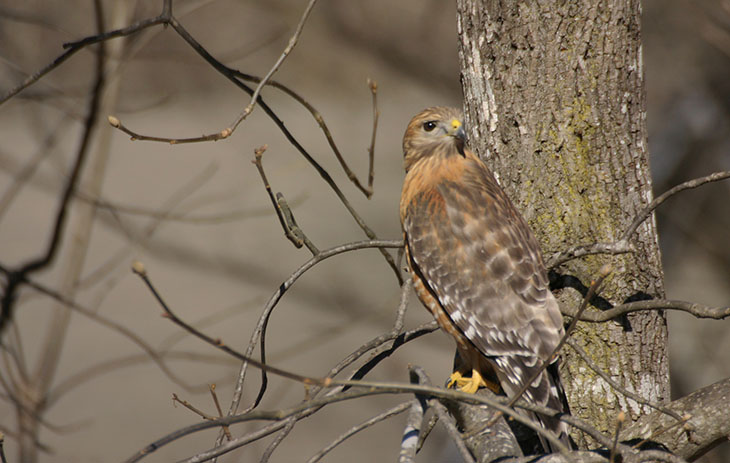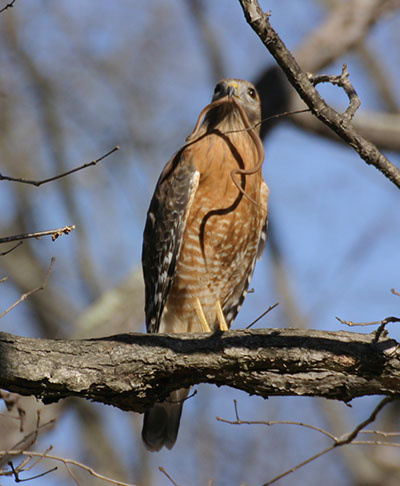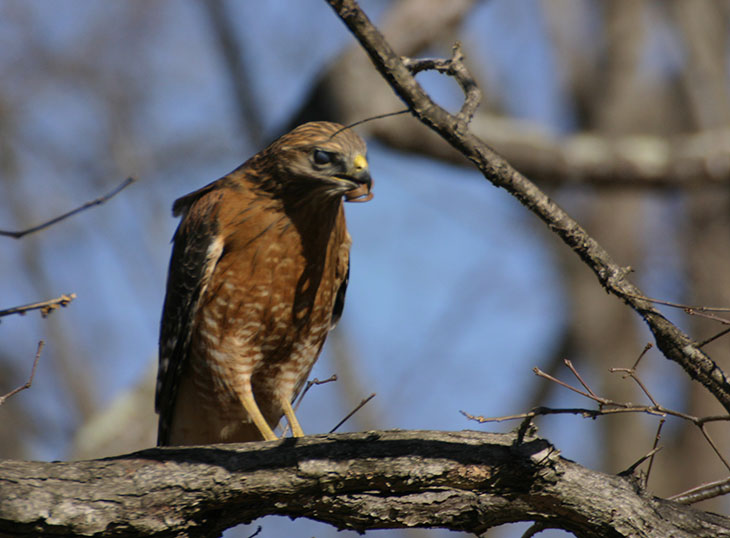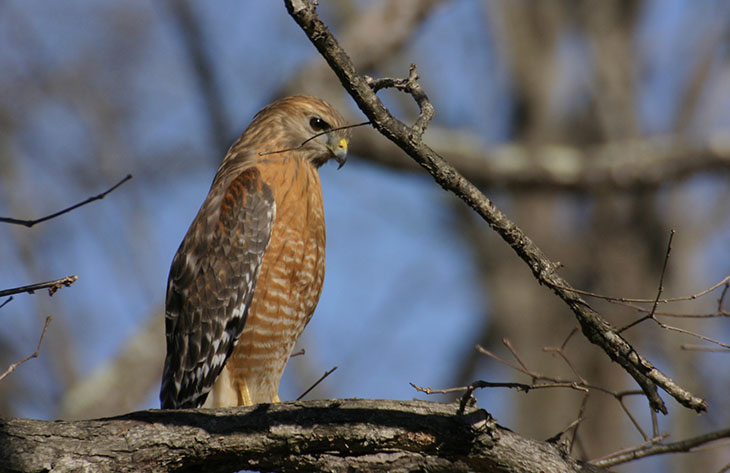I just happened to glance out the back door today to find a visitor to the yard, about as close to the door as she could get. After a couple of quick and low-quality shots through two panes of glass on the doors, I slipped out the front door to circle around and approach as unobtrusively as I could, which was sufficient.

She pretty clearly knew I was there, but I was in shadow and shooting along the edge of the house, so this red-shouldered hawk (Buteo lineatus) wasn’t too concerned with my presence, about 20 meters away. I took whatever opportunity she gave me (I’m fairly certain this is a female, and in fact, the same one seen here,) to creep closer, at times using a hoe as a makeshift monopod because I hadn’t grabbed one, or the tripod, figuring they were more likely to spook the bird. She switched position, and as I moved slowly to stay with her, she spotted something down by the fence and popped down there for just a moment.
 I’ve seen before the kind of dancing she did while grounded, and knew as she returned to another branch that she’d caught something. In this case it was a small brown snake (Storeria dekayi,) about the diameter of a pencil and not a whole lot longer, which provides a little bit of scale – the hawk probably stands about 30cm (12″) tall. Since I’d already alerted The Girlfriend to the presence of the hawk, she got to see the whole show through the window, easily noting that the snake seemed none too happy. Hawks only worry about immobilizing their food; it can be alive as they eat it, if necessary, so the snake was writhing in an attempt to get away.
I’ve seen before the kind of dancing she did while grounded, and knew as she returned to another branch that she’d caught something. In this case it was a small brown snake (Storeria dekayi,) about the diameter of a pencil and not a whole lot longer, which provides a little bit of scale – the hawk probably stands about 30cm (12″) tall. Since I’d already alerted The Girlfriend to the presence of the hawk, she got to see the whole show through the window, easily noting that the snake seemed none too happy. Hawks only worry about immobilizing their food; it can be alive as they eat it, if necessary, so the snake was writhing in an attempt to get away.
I was shooting lots of frames as she perched with the snake, looking around curiously to see if everyone noticed her remarkable feat; she was, after all, totally unscathed, hard as that may be to believe. Actually, I’ve seen this behavior before too, and I don’t know what the purpose is; I would think that hawks would want to get their meals down as quickly as possible, to prevent escapes, attracting attention, or even losing the meal to a rival. But instead they pause for no apparent reason, without doing anything useful, and my only speculation is that they ensure that their perch is safe before getting involved in consuming the meal.

Now, this makes sense for the larger meals that have to be reduced into bits that can be swallowed easily, since hawks aren’t going to be chewing anything. But not exactly for something like this, which doesn’t take a whole lot of effort. Still, it might just be habit. Unfortunately, digital cameras have a small handicap in that they have to process the images as they go, able to handle ‘bursts’ of several frames but requiring pauses in between, and it was during one of these pauses that the hawk chose to hork her capture down, taking all of two seconds to do so. Thus I only got one frame of this taking place.

Notice the nictitating third eyelid, often closed as birds swallow, presumably to protect the eye from the flailing that might take place from their food. It’s semi-transparent, so the hawk can still see danger approaching.
I can’t complain about the conditions – I couldn’t have asked for either a better light angle, or a better position from the hawk. We’re so used to seeing wildlife images of this nature that we often don’t realize how difficult it is to accomplish; the hawk could easily have been elsewhere, facing differently, or this could have taken place under overcast skies. But I still could have done without that tiny twig right there.

She loitered around for a bit, clearly looking for more of a meal than that, the glutton. She still wasn’t very worried about my presence, even though she had flown away not two weeks previously when I was three times farther off and far below her. I’m guessing the prospect of more snakes on this warm day made her tolerate creepy little nature photographers a little better.



















































